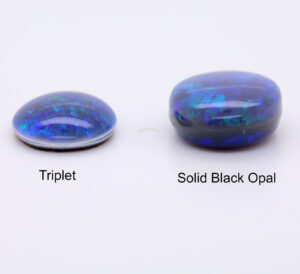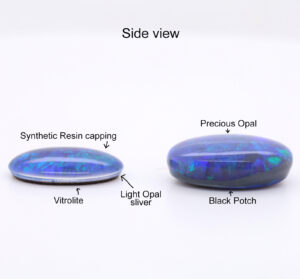Frequently Asked Questions: What is a Doublet Opal? What is a Triplet Opal? What is the difference between Doublets, Triplets and Solid Opals? What happens when Doublets or Triplets get wet? Why do some opals go cloudy? How should I care for a Doublet or Triplet?
Terminologies you should familiarise yourself with when it comes to the world of opal are that of Doublet Opal and Triplet Opal – or Doublets and Triplets. These are partially fabricated gems that consist of a thin slice of light opal, adhered to a darker backing, designed to imitate the appearance of a solid Black Opal. The darker backing glued under the light opal sliver causes the colour to become much darker, more vibrant and intense. You will find that Doublet Opal and Triplet Opal are generally less expensive than solid Black Opals as they only consist of a small amount of genuine solid opal.
Doublets
Doublet Opals (or Doublets) consist of a two layers adhered together by jeweller’s adhesive:
- A thin slice of light opal (so, Crystal or White Opal). The thickness of the opal in a Doublet can vary, however it is most often thicker than the sliver of opal used in the construction of a Triplet Opal. The edges of the opal sliver in a Doublet are generally rounded off (if the opal layer is thick enough), to vie the stone a cabochon (domed top).
- A dark backing which consists of either Black Industrial Glass (not commonly used), Black ‘Potch’ (common or colourless opal), or most commonly, brown ironstone (the host rock of natural Boulder Opal).
You can usually identify a Doublet by inspecting it from the side (that is if the Doublet is unset, or in a setting that allows unobstructed viewing from a side angle). If the opal is indeed a Doublet, you should be able to see where the opal layer and the dark backing are adhered together – you will notice a perfectly straight line between the two layers. If a Doublet is set into jewellery with the sides covered, it can be extremely difficult, even for an expert, to tell whether it is a Doublet or a Solid Australian Opal, but a tell-tale sign would be a flat cabochon. Since the top of the stone consists of pure opal (and therefore appearing exactly like a Black Opal or Boulder Opal), Doublets can have a much more natural appearance compared to Triplet Opal.
Triplets
Triplets, or Triplet Opal consist of three layers:
- A paper-thin (approximately 3mm) slice of light opal in the middle.
- A black backing, generally Vitrolite (Blackened Industrial Glass) or, in the case of older Triplets, Black ‘Potch’ (colourless or common opal)
- A clear glass, quartz or resin capping in the shape of a medium cabochon (dome). Due to the sliver/slice of light opal that is used in a Triplet being extremely thin, the clear capping serves to provide the stone with protective cabochon, but also may magnify the colour of the opal slightly.
You can identify a Triplet Opal due to the clear non-opal capping that is the top layer – an experienced opal valuer/cutter/collector should be able to verify a Triplet immediately by its appearance. Triplets will have a ‘glassy’ appearance and light will reflect differently from the top of the ‘stone’. By viewing the Triplet from the side, you will be able to witness the straight line where the three layers meet, but also look at the (suspected) Triplet from the back. If the back of the opal appears to be black plastic-like, then you are not looking at a solid stone. If the Triplet is completely surrounded by metal, viewing from the side will show the clear capping, which you should be able to see through (somewhat). Also note, as mentioned earlier, older Triplets could utilise Black ‘Potch’ as the backing, which can be deceiving.
Triplets will be generally cheaper than Doublets due to less per opal being used. Because the top of the stone can be made from synthetic material, Triplets can be a lot more resistant to impact than a solid Australian Opal or Doublet (with Australian Opal, by its nature, being a softer gem).
Caring for Doublets and Triplets
Due to Doublets and Triplets consisting of multiple layers adhered together, prolonged exposure to and/or immersion in water could cause lifting between the layers and infiltration of moisture. This does not mean that your Doublet or Triplet will be ruined if it is worn in the shower once, or caught in the rain with it on, however. If water penetration occurs, a Triplet Opal will start to take on a foggy or ‘cloudy’ appearance, and you may even notice condensation within the stone. In the case of a Doublet Opal being water-affected, you will begin to notice the areas where the adhesive has been damaged by moisture will begin to lift and the opal layer will begin to peel away. It is highly advised that you should avoid getting a Triplet or Doublet Opal wet to avoid any water penetration. This also goes for Inlaid Opal (Opal inlay jewellery, such as rings or earrings, where there are slices of opal glued into the setting).
Do please note: We acknowledge there can be a lot of confusion regarding the care of opals due to the different care instructions for solid Australian Opals, as opposed to Doublets and Triplets. Solid Australian Opals are completely fine in water. It is only Doublets and Triplets which need to be kept out of water to avoid moisture penetration. Getting a solid Australian Opal wet will do no damage whatsoever.
Cleaning: Doublets and Triplets may be wiped with a damp soft cloth and mild detergent, but should never be soaked or immersed. Avoid bleach, chemicals, cleaners and Ultrasonic cleaners.
Summary
Doublets and Triplets can be a fantastic alternative to solid Australian Opal, given they are far less expensive than solid Black Opals. Given that solid Black Opals with the same appearance as a Triplet or Doublet can be ten times the price (due to their rarity and appeal), Triplets and Doublets serve a useful purpose in making stunningly beautiful dark opals more affordable. We do advise that you be made aware of what you are purchasing, and know how to correctly care for Doublets and Triplets to best maintain their longevity.



